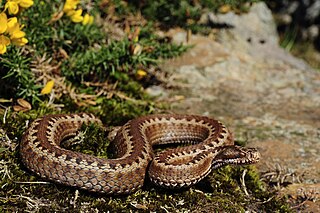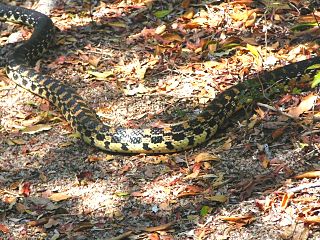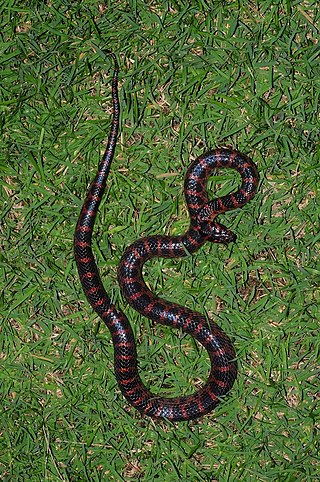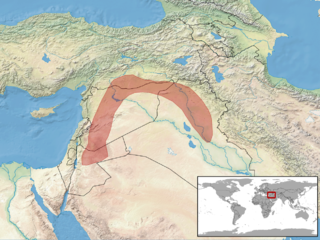
Ablepharus is a genus of skinks that contains the common snake-eyed skinks. Both their scientific and common names refer to the fact that their eyelids have fused to a translucent capsule; as in snakes, they thus are physically incapable of blinking. They are small lizards and prefer to live in the leaf litter of dry fields and hills. Their scales give them a very shiny, bronze appearance with a characteristically dark stripe down the sides of their bodies. They prey on small insects and other small mollusks.

Cerastes cerastes, commonly known as the Saharan horned viper or the desert horned viper, is a venomous species of viper native to the deserts of Northern Africa and parts of the Arabian Peninsula and Levant. It is often easily recognized by the presence of a pair of supraocular "horns", although hornless individuals do occur. Three subspecies have been described.

Macrovipera lebetinus, known as the blunt-nosed viper, Lebetine viper, Levant viper, and by other common names, is a viper species found in North Africa, much of the Middle East, and as far east as Kashmir. Like all other vipers, it is venomous. Five subspecies are currently recognized, including the nominate race described here.

Field's horned viper is a species of snake in the family Viperidae. The species is native to the deserts of the Middle East. Like all other vipers, it is venomous. It was previously considered a subspecies of the Persian horned viper. The main differences between this species and the Persian horned viper are in scalation and venom composition.

Lytorhynchus paradoxus, commonly known as the Sindh awl-headed snake and the Sind longnose sand snake, is a species of snake in the family Colubridae. The species is native to the desert areas of Pakistan and India (Rajasthan).

The Indian fringe-fingered lizard, also known commonly as the Indian fringe-toed lizard, is a species of lizard in the family Lacertidae. The species is endemic to Asia.

Cerastes gasperettii, also known commonly as the Arabian horned viper and Gasperetti's horned viper, is a species of venomous snake in the subfamily Viperinae of the family Viperidae. The species is native to the Arabian Peninsula and north to Palestine (region), Iraq, and Iran. It is very similar in appearance to C. cerastes, but the geographic ranges of these two species do not overlap. No subspecies of C. gasperettii are recognized.

The desert death adder is a species of snake native to Australia and is one of the most venomous land snakes in the world. The desert death adder is under threat due to the destruction of habitat.

Vipera latastei, known as Lataste's viper, the snub-nosed viper, and the snub-nosed adder, is a species of venomous snake in the subfamily Viperinae of the family Viperidae. The species is endemic to the Iberian Peninsula and northwestern Maghreb. Three extant subspecies and one extinct subspecies are currently recognized, including the nominate subspecies described here.

Montivipera latifii, known as Latifi's viper, the Iranian valley viper, or the Lar Valley viper, is a species of venomous snake in the subfamily Viperinae of the family Viperidae. The species is endemic to Iran. There are no subspecies that are recognized as being valid.

Vipera seoanei is a venomous viper species endemic to extreme southwestern France and the northern regions of Spain and Portugal. Two subspecies are currently recognized, including the nominate race described here.

The wildlife of Jordan includes its flora and fauna and their natural habitats. Although much of the country is desert, it has several geographic regions, each with a diversity of plants and animals adapted to their own particular habitats. Fossil finds show that in Palaeolithic times, the region had Syrian brown bears, Asiatic lions, zebras, Asian elephants, and rhinoceroses, but these species are all now extinct in this region.

The Persian horned viper, known as the Persian horned viper, false horned viper, and by other common names, is a species of vipers endemic to the Middle East and Asia. Like all other vipers, it is venomous.
Telescopus hoogstraali, common names of which include Hoogstraal's cat snake and the Sinai cat snake, is an endangered species of snake in the family Colubridae. The species is native to the Middle East.

Leioheterodon geayi, commonly known as Geay's hognose snake, the Madagascan speckled hognose snake, and the speckled hognose snake, is a species of mildly venomous snake in the family Lamprophiidae. The species is native to southwestern Madagascar.

Lycodon rufozonatus is a species of snake in the family Colubridae. The species is native to East Asia. It is medium-sized, nocturnal, and is considered non-venomous. Two subspecies are recognised, one of which, L. r. walli, is restricted to the Ryukyu Archipelago.
Eirenis coronella or crowned dwarf racer, is a non-venomous snake found in the Near and Middle East.

Eirenis coronelloides or is a non-venomous snake found in the Middle East.

Eirenis decemlineatus (also known as the narrow-striped dwarf snake, is a non-venomous snake found in West Asia and the Middle East.

Lytorhynchus diadema, the crowned leafnose snake, diademed sand snake, or awl-headed snake, is a non-venomous snake found in Middle East, North Africa & West Asia.

















